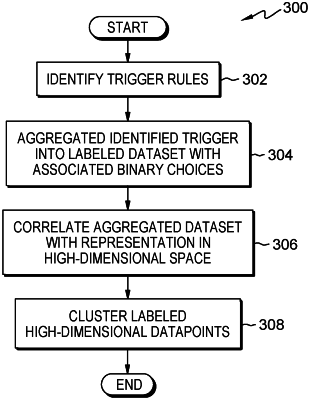| CPC H04L 63/1425 (2013.01) [G06N 5/027 (2013.01); G06N 5/04 (2013.01); G06N 20/00 (2019.01)] | 20 Claims |

|
1. A computer-implemented method comprising:
creating, by one or more computer processors, a binary cluster of events by bootstrapping a set of ground truths contained with a rule engine applied to a set of high-dimensional datapoints, wherein the binary cluster contains two clusters each containing a plurality of high-dimensional datapoints;
determining, by one or more computer processors, one or more peer groups for a set of unknown high-dimensional datapoints utilizing a trained multiclass classifier, wherein the high-dimensional datapoints are assigned to one or more peer groups by the trained multiclass classifier using an incremental learning algorithm in order to reduce system resources;
creating, by one or more computer processors, an activity distribution for each unknown high-dimensional datapoint associated with a user in the set of unknown high-dimensional datapoints and each peer group;
calculating, by one or more computer processors, a deviation percentage between the activity distribution of the user and each peer group associated with the user; and
responsive to exceeding a deviation threshold, classifying, by one or more computer processors, the user or associated high-dimensional datapoints as risky and performing an action.
|